Research Project: Employee Retention Strategies at Berkeley Hotel
VerifiedAdded on 2023/01/19
|27
|7430
|26
Report
AI Summary
This research project examines employee retention strategies at the Berkeley Hotel, a well-known establishment in London's Knightsbridge within the UK's hospitality industry. The study investigates the reasons behind low employee retention rates, focusing on the role of line managers in talent management. It explores factors motivating employees to stay with the firm, such as financial and non-financial aspects, including working environment and manager-employee relationships. The report includes a literature review discussing various perspectives on employee retention, research methodology involving qualitative research and thematic analysis, and data analysis to identify key issues and suggest recommendations for improvement. The project aims to identify strategies the hotel can implement to enhance employee retention, ultimately improving the business's operational growth and sustainability. The study highlights the importance of addressing employee morale, providing clear career paths, and fostering positive employer-employee relationships to reduce employee turnover and improve client satisfaction. This report is contributed by a student to Desklib, a platform providing AI-based study tools for students.

RESEARCH PROJECT
Paraphrase This Document
Need a fresh take? Get an instant paraphrase of this document with our AI Paraphraser
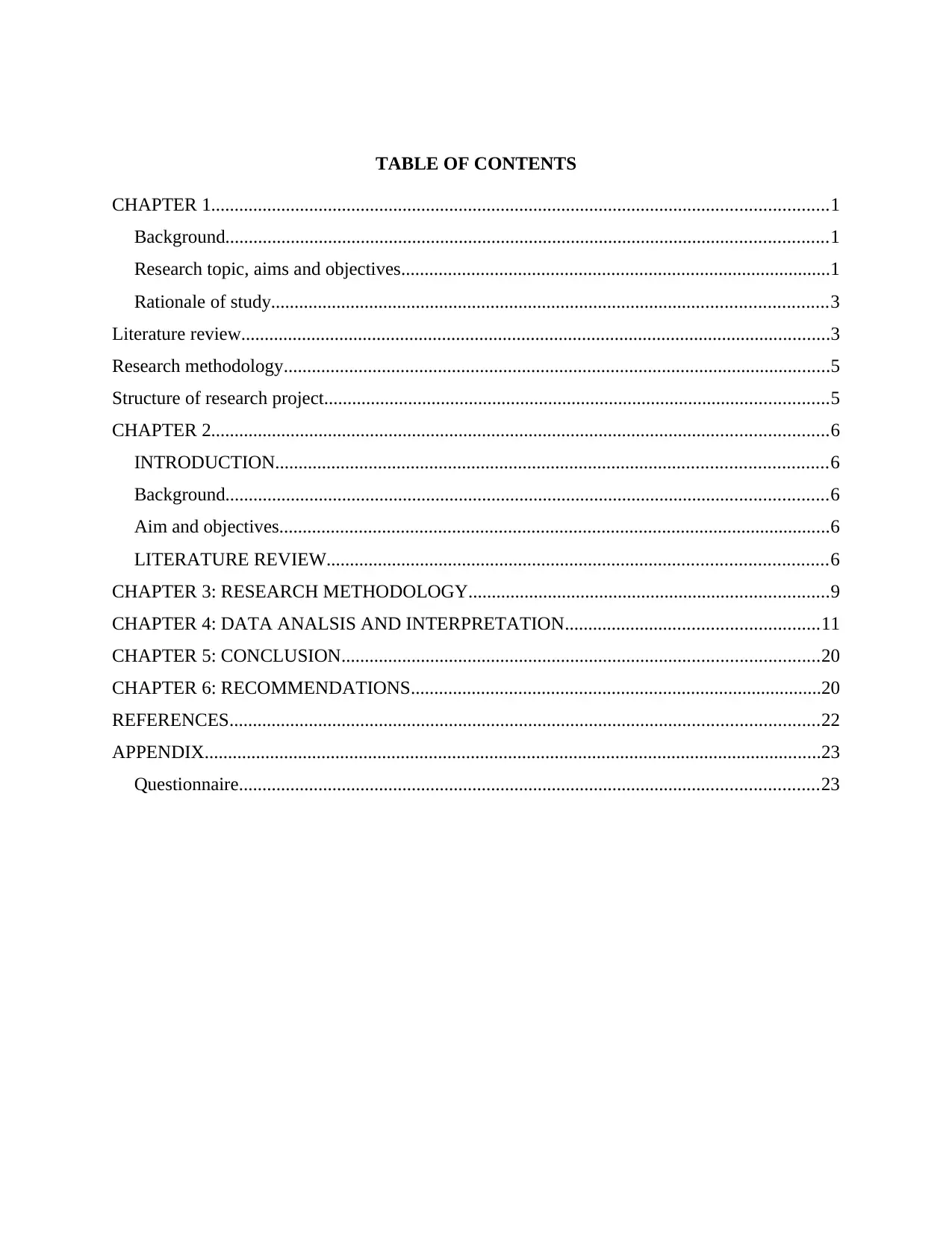
TABLE OF CONTENTS
CHAPTER 1....................................................................................................................................1
Background.................................................................................................................................1
Research topic, aims and objectives............................................................................................1
Rationale of study.......................................................................................................................3
Literature review..............................................................................................................................3
Research methodology.....................................................................................................................5
Structure of research project............................................................................................................5
CHAPTER 2....................................................................................................................................6
INTRODUCTION......................................................................................................................6
Background.................................................................................................................................6
Aim and objectives......................................................................................................................6
LITERATURE REVIEW...........................................................................................................6
CHAPTER 3: RESEARCH METHODOLOGY.............................................................................9
CHAPTER 4: DATA ANALSIS AND INTERPRETATION......................................................11
CHAPTER 5: CONCLUSION......................................................................................................20
CHAPTER 6: RECOMMENDATIONS........................................................................................20
REFERENCES..............................................................................................................................22
APPENDIX....................................................................................................................................23
Questionnaire............................................................................................................................23
CHAPTER 1....................................................................................................................................1
Background.................................................................................................................................1
Research topic, aims and objectives............................................................................................1
Rationale of study.......................................................................................................................3
Literature review..............................................................................................................................3
Research methodology.....................................................................................................................5
Structure of research project............................................................................................................5
CHAPTER 2....................................................................................................................................6
INTRODUCTION......................................................................................................................6
Background.................................................................................................................................6
Aim and objectives......................................................................................................................6
LITERATURE REVIEW...........................................................................................................6
CHAPTER 3: RESEARCH METHODOLOGY.............................................................................9
CHAPTER 4: DATA ANALSIS AND INTERPRETATION......................................................11
CHAPTER 5: CONCLUSION......................................................................................................20
CHAPTER 6: RECOMMENDATIONS........................................................................................20
REFERENCES..............................................................................................................................22
APPENDIX....................................................................................................................................23
Questionnaire............................................................................................................................23
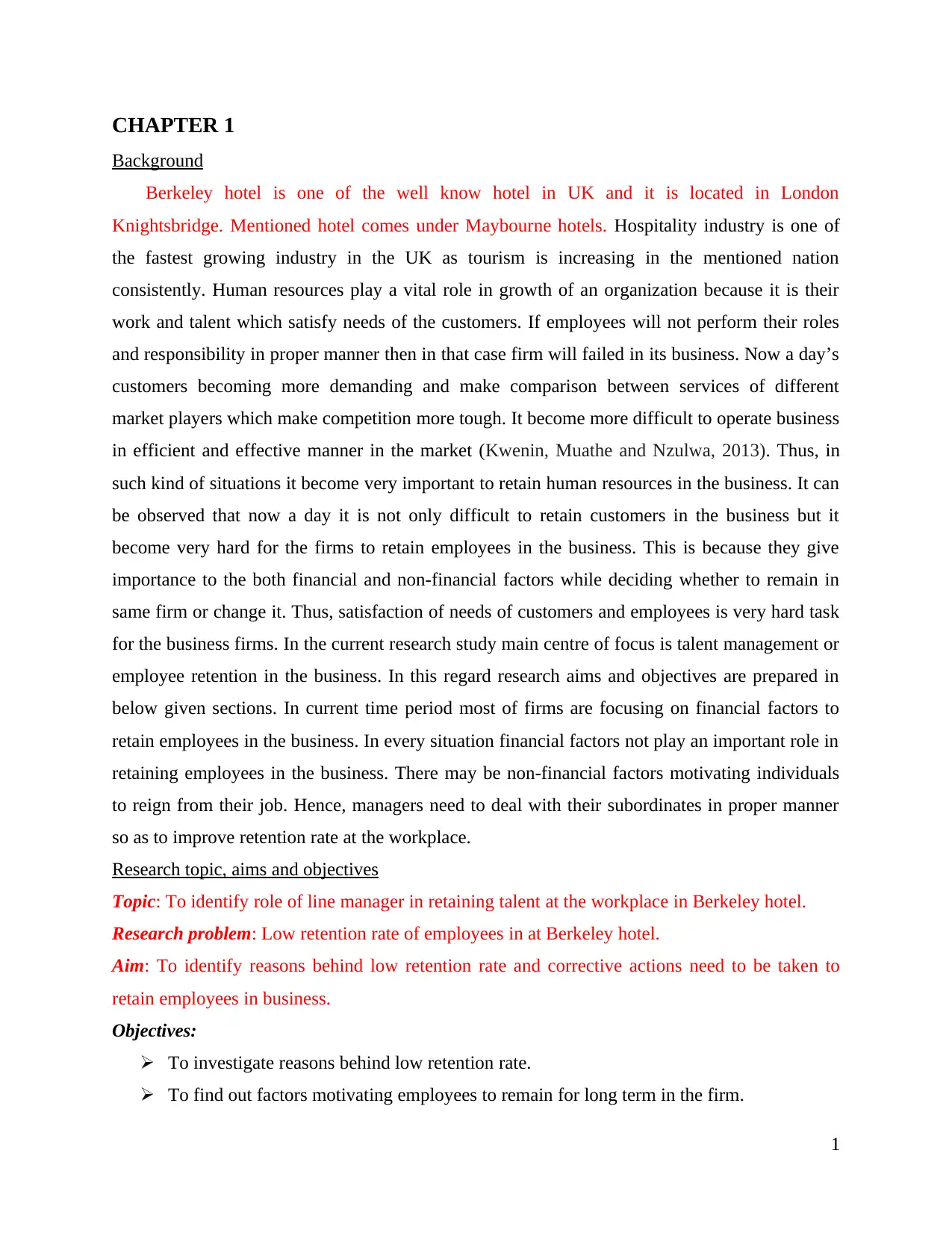
CHAPTER 1
Background
Berkeley hotel is one of the well know hotel in UK and it is located in London
Knightsbridge. Mentioned hotel comes under Maybourne hotels. Hospitality industry is one of
the fastest growing industry in the UK as tourism is increasing in the mentioned nation
consistently. Human resources play a vital role in growth of an organization because it is their
work and talent which satisfy needs of the customers. If employees will not perform their roles
and responsibility in proper manner then in that case firm will failed in its business. Now a day’s
customers becoming more demanding and make comparison between services of different
market players which make competition more tough. It become more difficult to operate business
in efficient and effective manner in the market (Kwenin, Muathe and Nzulwa, 2013). Thus, in
such kind of situations it become very important to retain human resources in the business. It can
be observed that now a day it is not only difficult to retain customers in the business but it
become very hard for the firms to retain employees in the business. This is because they give
importance to the both financial and non-financial factors while deciding whether to remain in
same firm or change it. Thus, satisfaction of needs of customers and employees is very hard task
for the business firms. In the current research study main centre of focus is talent management or
employee retention in the business. In this regard research aims and objectives are prepared in
below given sections. In current time period most of firms are focusing on financial factors to
retain employees in the business. In every situation financial factors not play an important role in
retaining employees in the business. There may be non-financial factors motivating individuals
to reign from their job. Hence, managers need to deal with their subordinates in proper manner
so as to improve retention rate at the workplace.
Research topic, aims and objectives
Topic: To identify role of line manager in retaining talent at the workplace in Berkeley hotel.
Research problem: Low retention rate of employees in at Berkeley hotel.
Aim: To identify reasons behind low retention rate and corrective actions need to be taken to
retain employees in business.
Objectives:
To investigate reasons behind low retention rate.
To find out factors motivating employees to remain for long term in the firm.
1
Background
Berkeley hotel is one of the well know hotel in UK and it is located in London
Knightsbridge. Mentioned hotel comes under Maybourne hotels. Hospitality industry is one of
the fastest growing industry in the UK as tourism is increasing in the mentioned nation
consistently. Human resources play a vital role in growth of an organization because it is their
work and talent which satisfy needs of the customers. If employees will not perform their roles
and responsibility in proper manner then in that case firm will failed in its business. Now a day’s
customers becoming more demanding and make comparison between services of different
market players which make competition more tough. It become more difficult to operate business
in efficient and effective manner in the market (Kwenin, Muathe and Nzulwa, 2013). Thus, in
such kind of situations it become very important to retain human resources in the business. It can
be observed that now a day it is not only difficult to retain customers in the business but it
become very hard for the firms to retain employees in the business. This is because they give
importance to the both financial and non-financial factors while deciding whether to remain in
same firm or change it. Thus, satisfaction of needs of customers and employees is very hard task
for the business firms. In the current research study main centre of focus is talent management or
employee retention in the business. In this regard research aims and objectives are prepared in
below given sections. In current time period most of firms are focusing on financial factors to
retain employees in the business. In every situation financial factors not play an important role in
retaining employees in the business. There may be non-financial factors motivating individuals
to reign from their job. Hence, managers need to deal with their subordinates in proper manner
so as to improve retention rate at the workplace.
Research topic, aims and objectives
Topic: To identify role of line manager in retaining talent at the workplace in Berkeley hotel.
Research problem: Low retention rate of employees in at Berkeley hotel.
Aim: To identify reasons behind low retention rate and corrective actions need to be taken to
retain employees in business.
Objectives:
To investigate reasons behind low retention rate.
To find out factors motivating employees to remain for long term in the firm.
1
⊘ This is a preview!⊘
Do you want full access?
Subscribe today to unlock all pages.

Trusted by 1+ million students worldwide
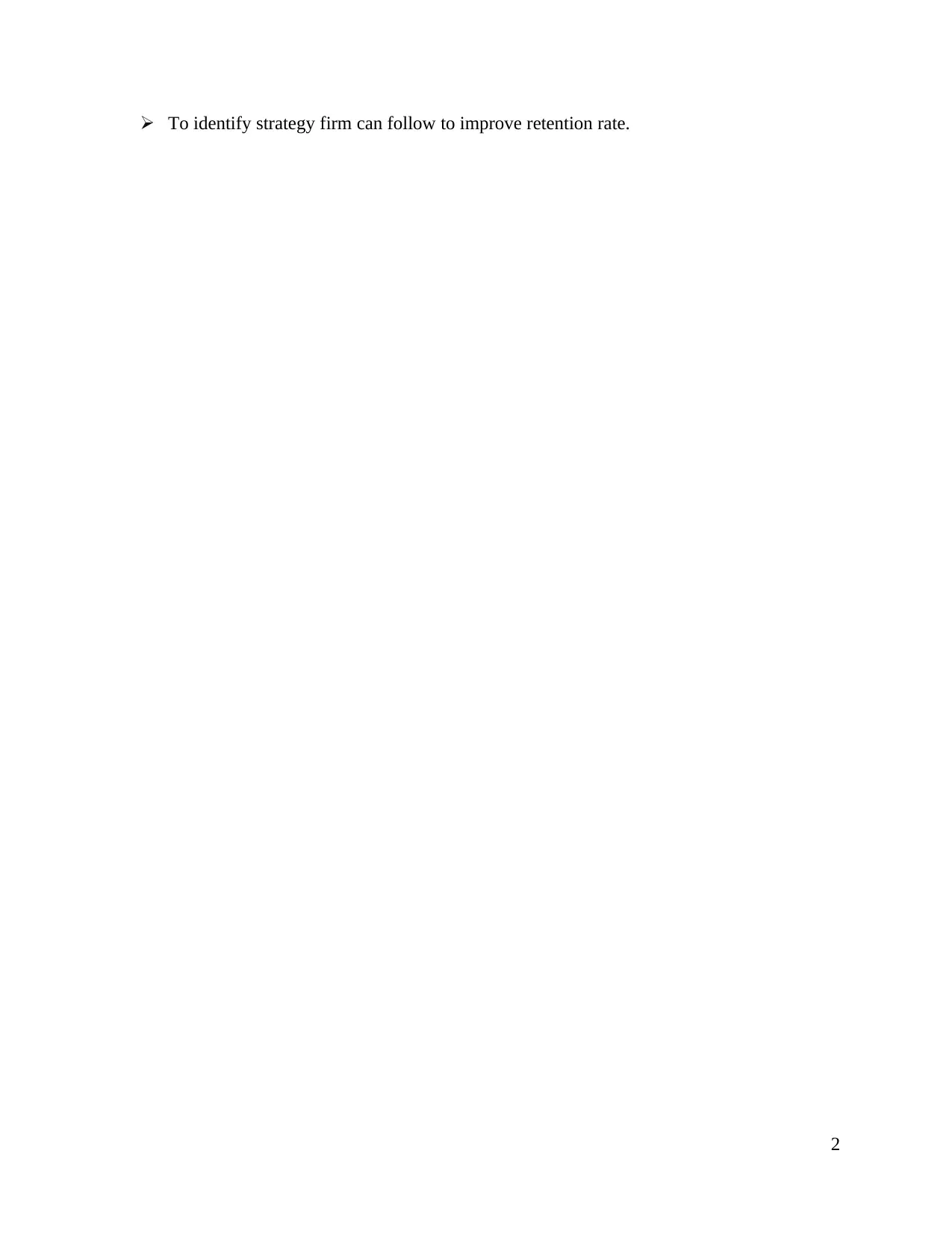
To identify strategy firm can follow to improve retention rate.
2
2
Paraphrase This Document
Need a fresh take? Get an instant paraphrase of this document with our AI Paraphraser
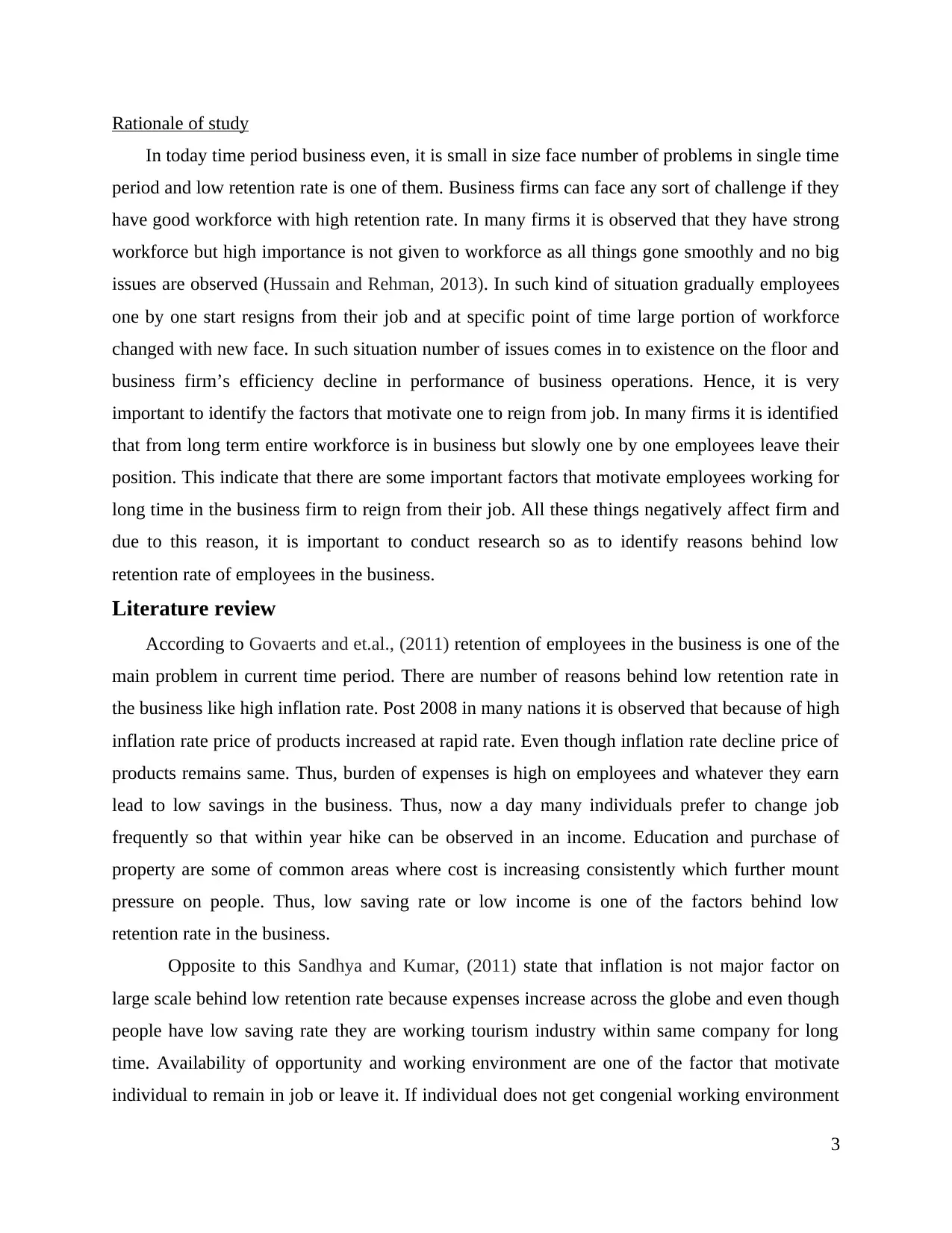
Rationale of study
In today time period business even, it is small in size face number of problems in single time
period and low retention rate is one of them. Business firms can face any sort of challenge if they
have good workforce with high retention rate. In many firms it is observed that they have strong
workforce but high importance is not given to workforce as all things gone smoothly and no big
issues are observed (Hussain and Rehman, 2013). In such kind of situation gradually employees
one by one start resigns from their job and at specific point of time large portion of workforce
changed with new face. In such situation number of issues comes in to existence on the floor and
business firm’s efficiency decline in performance of business operations. Hence, it is very
important to identify the factors that motivate one to reign from job. In many firms it is identified
that from long term entire workforce is in business but slowly one by one employees leave their
position. This indicate that there are some important factors that motivate employees working for
long time in the business firm to reign from their job. All these things negatively affect firm and
due to this reason, it is important to conduct research so as to identify reasons behind low
retention rate of employees in the business.
Literature review
According to Govaerts and et.al., (2011) retention of employees in the business is one of the
main problem in current time period. There are number of reasons behind low retention rate in
the business like high inflation rate. Post 2008 in many nations it is observed that because of high
inflation rate price of products increased at rapid rate. Even though inflation rate decline price of
products remains same. Thus, burden of expenses is high on employees and whatever they earn
lead to low savings in the business. Thus, now a day many individuals prefer to change job
frequently so that within year hike can be observed in an income. Education and purchase of
property are some of common areas where cost is increasing consistently which further mount
pressure on people. Thus, low saving rate or low income is one of the factors behind low
retention rate in the business.
Opposite to this Sandhya and Kumar, (2011) state that inflation is not major factor on
large scale behind low retention rate because expenses increase across the globe and even though
people have low saving rate they are working tourism industry within same company for long
time. Availability of opportunity and working environment are one of the factor that motivate
individual to remain in job or leave it. If individual does not get congenial working environment
3
In today time period business even, it is small in size face number of problems in single time
period and low retention rate is one of them. Business firms can face any sort of challenge if they
have good workforce with high retention rate. In many firms it is observed that they have strong
workforce but high importance is not given to workforce as all things gone smoothly and no big
issues are observed (Hussain and Rehman, 2013). In such kind of situation gradually employees
one by one start resigns from their job and at specific point of time large portion of workforce
changed with new face. In such situation number of issues comes in to existence on the floor and
business firm’s efficiency decline in performance of business operations. Hence, it is very
important to identify the factors that motivate one to reign from job. In many firms it is identified
that from long term entire workforce is in business but slowly one by one employees leave their
position. This indicate that there are some important factors that motivate employees working for
long time in the business firm to reign from their job. All these things negatively affect firm and
due to this reason, it is important to conduct research so as to identify reasons behind low
retention rate of employees in the business.
Literature review
According to Govaerts and et.al., (2011) retention of employees in the business is one of the
main problem in current time period. There are number of reasons behind low retention rate in
the business like high inflation rate. Post 2008 in many nations it is observed that because of high
inflation rate price of products increased at rapid rate. Even though inflation rate decline price of
products remains same. Thus, burden of expenses is high on employees and whatever they earn
lead to low savings in the business. Thus, now a day many individuals prefer to change job
frequently so that within year hike can be observed in an income. Education and purchase of
property are some of common areas where cost is increasing consistently which further mount
pressure on people. Thus, low saving rate or low income is one of the factors behind low
retention rate in the business.
Opposite to this Sandhya and Kumar, (2011) state that inflation is not major factor on
large scale behind low retention rate because expenses increase across the globe and even though
people have low saving rate they are working tourism industry within same company for long
time. Availability of opportunity and working environment are one of the factor that motivate
individual to remain in job or leave it. If individual does not get congenial working environment
3
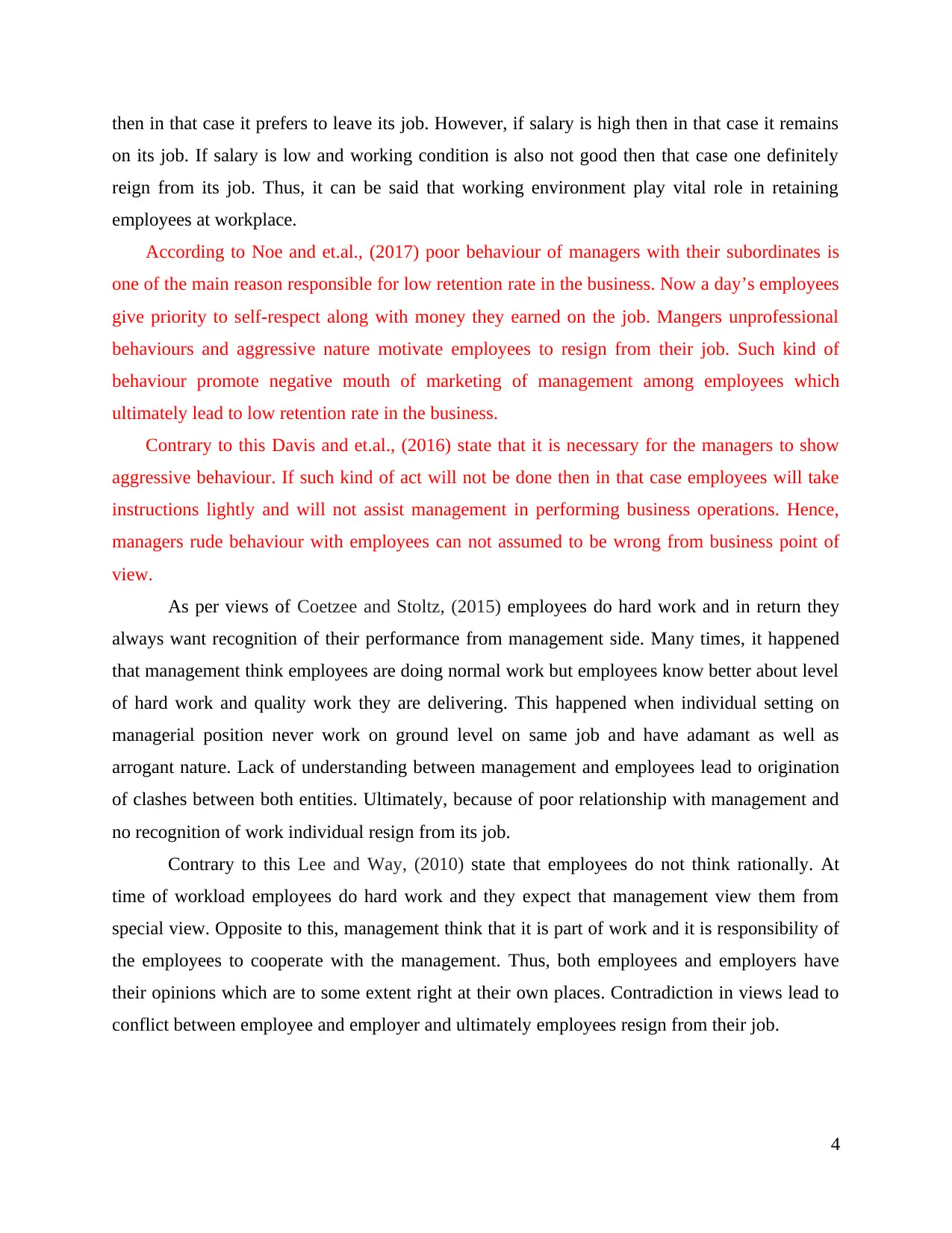
then in that case it prefers to leave its job. However, if salary is high then in that case it remains
on its job. If salary is low and working condition is also not good then that case one definitely
reign from its job. Thus, it can be said that working environment play vital role in retaining
employees at workplace.
According to Noe and et.al., (2017) poor behaviour of managers with their subordinates is
one of the main reason responsible for low retention rate in the business. Now a day’s employees
give priority to self-respect along with money they earned on the job. Mangers unprofessional
behaviours and aggressive nature motivate employees to resign from their job. Such kind of
behaviour promote negative mouth of marketing of management among employees which
ultimately lead to low retention rate in the business.
Contrary to this Davis and et.al., (2016) state that it is necessary for the managers to show
aggressive behaviour. If such kind of act will not be done then in that case employees will take
instructions lightly and will not assist management in performing business operations. Hence,
managers rude behaviour with employees can not assumed to be wrong from business point of
view.
As per views of Coetzee and Stoltz, (2015) employees do hard work and in return they
always want recognition of their performance from management side. Many times, it happened
that management think employees are doing normal work but employees know better about level
of hard work and quality work they are delivering. This happened when individual setting on
managerial position never work on ground level on same job and have adamant as well as
arrogant nature. Lack of understanding between management and employees lead to origination
of clashes between both entities. Ultimately, because of poor relationship with management and
no recognition of work individual resign from its job.
Contrary to this Lee and Way, (2010) state that employees do not think rationally. At
time of workload employees do hard work and they expect that management view them from
special view. Opposite to this, management think that it is part of work and it is responsibility of
the employees to cooperate with the management. Thus, both employees and employers have
their opinions which are to some extent right at their own places. Contradiction in views lead to
conflict between employee and employer and ultimately employees resign from their job.
4
on its job. If salary is low and working condition is also not good then that case one definitely
reign from its job. Thus, it can be said that working environment play vital role in retaining
employees at workplace.
According to Noe and et.al., (2017) poor behaviour of managers with their subordinates is
one of the main reason responsible for low retention rate in the business. Now a day’s employees
give priority to self-respect along with money they earned on the job. Mangers unprofessional
behaviours and aggressive nature motivate employees to resign from their job. Such kind of
behaviour promote negative mouth of marketing of management among employees which
ultimately lead to low retention rate in the business.
Contrary to this Davis and et.al., (2016) state that it is necessary for the managers to show
aggressive behaviour. If such kind of act will not be done then in that case employees will take
instructions lightly and will not assist management in performing business operations. Hence,
managers rude behaviour with employees can not assumed to be wrong from business point of
view.
As per views of Coetzee and Stoltz, (2015) employees do hard work and in return they
always want recognition of their performance from management side. Many times, it happened
that management think employees are doing normal work but employees know better about level
of hard work and quality work they are delivering. This happened when individual setting on
managerial position never work on ground level on same job and have adamant as well as
arrogant nature. Lack of understanding between management and employees lead to origination
of clashes between both entities. Ultimately, because of poor relationship with management and
no recognition of work individual resign from its job.
Contrary to this Lee and Way, (2010) state that employees do not think rationally. At
time of workload employees do hard work and they expect that management view them from
special view. Opposite to this, management think that it is part of work and it is responsibility of
the employees to cooperate with the management. Thus, both employees and employers have
their opinions which are to some extent right at their own places. Contradiction in views lead to
conflict between employee and employer and ultimately employees resign from their job.
4
⊘ This is a preview!⊘
Do you want full access?
Subscribe today to unlock all pages.

Trusted by 1+ million students worldwide
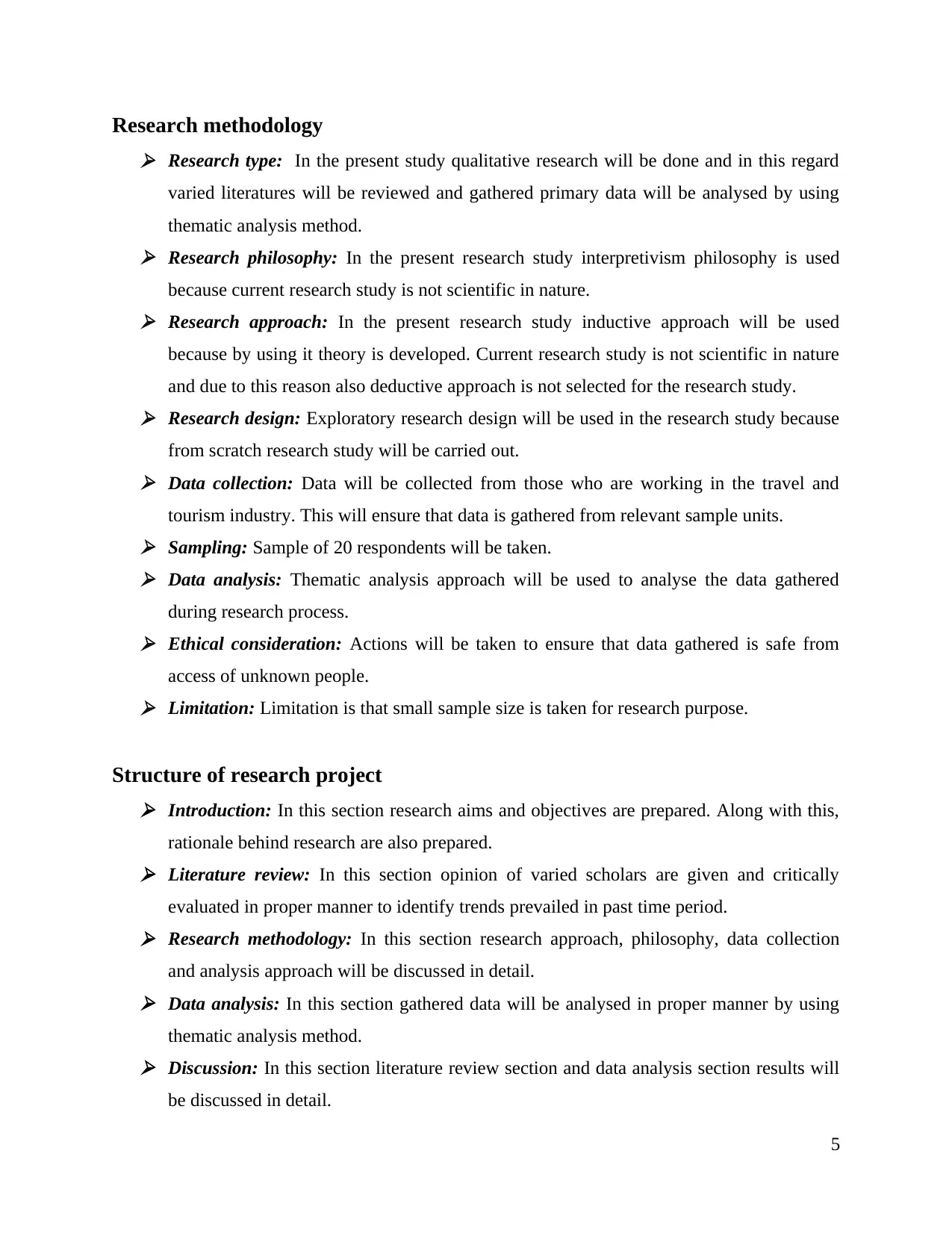
Research methodology Research type: In the present study qualitative research will be done and in this regard
varied literatures will be reviewed and gathered primary data will be analysed by using
thematic analysis method. Research philosophy: In the present research study interpretivism philosophy is used
because current research study is not scientific in nature. Research approach: In the present research study inductive approach will be used
because by using it theory is developed. Current research study is not scientific in nature
and due to this reason also deductive approach is not selected for the research study. Research design: Exploratory research design will be used in the research study because
from scratch research study will be carried out. Data collection: Data will be collected from those who are working in the travel and
tourism industry. This will ensure that data is gathered from relevant sample units. Sampling: Sample of 20 respondents will be taken. Data analysis: Thematic analysis approach will be used to analyse the data gathered
during research process. Ethical consideration: Actions will be taken to ensure that data gathered is safe from
access of unknown people. Limitation: Limitation is that small sample size is taken for research purpose.
Structure of research project Introduction: In this section research aims and objectives are prepared. Along with this,
rationale behind research are also prepared. Literature review: In this section opinion of varied scholars are given and critically
evaluated in proper manner to identify trends prevailed in past time period. Research methodology: In this section research approach, philosophy, data collection
and analysis approach will be discussed in detail. Data analysis: In this section gathered data will be analysed in proper manner by using
thematic analysis method. Discussion: In this section literature review section and data analysis section results will
be discussed in detail.
5
varied literatures will be reviewed and gathered primary data will be analysed by using
thematic analysis method. Research philosophy: In the present research study interpretivism philosophy is used
because current research study is not scientific in nature. Research approach: In the present research study inductive approach will be used
because by using it theory is developed. Current research study is not scientific in nature
and due to this reason also deductive approach is not selected for the research study. Research design: Exploratory research design will be used in the research study because
from scratch research study will be carried out. Data collection: Data will be collected from those who are working in the travel and
tourism industry. This will ensure that data is gathered from relevant sample units. Sampling: Sample of 20 respondents will be taken. Data analysis: Thematic analysis approach will be used to analyse the data gathered
during research process. Ethical consideration: Actions will be taken to ensure that data gathered is safe from
access of unknown people. Limitation: Limitation is that small sample size is taken for research purpose.
Structure of research project Introduction: In this section research aims and objectives are prepared. Along with this,
rationale behind research are also prepared. Literature review: In this section opinion of varied scholars are given and critically
evaluated in proper manner to identify trends prevailed in past time period. Research methodology: In this section research approach, philosophy, data collection
and analysis approach will be discussed in detail. Data analysis: In this section gathered data will be analysed in proper manner by using
thematic analysis method. Discussion: In this section literature review section and data analysis section results will
be discussed in detail.
5
Paraphrase This Document
Need a fresh take? Get an instant paraphrase of this document with our AI Paraphraser
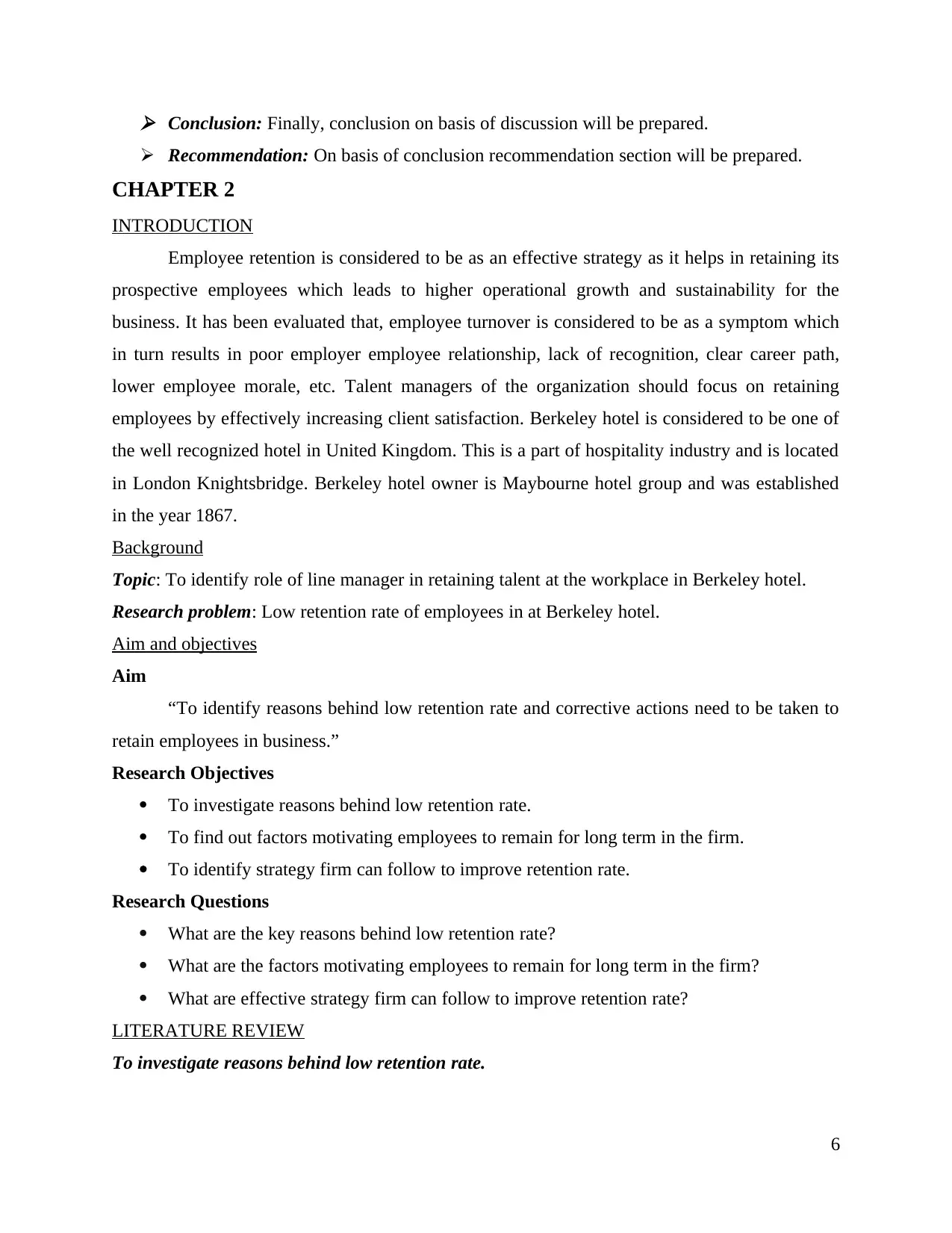
Conclusion: Finally, conclusion on basis of discussion will be prepared.
Recommendation: On basis of conclusion recommendation section will be prepared.
CHAPTER 2
INTRODUCTION
Employee retention is considered to be as an effective strategy as it helps in retaining its
prospective employees which leads to higher operational growth and sustainability for the
business. It has been evaluated that, employee turnover is considered to be as a symptom which
in turn results in poor employer employee relationship, lack of recognition, clear career path,
lower employee morale, etc. Talent managers of the organization should focus on retaining
employees by effectively increasing client satisfaction. Berkeley hotel is considered to be one of
the well recognized hotel in United Kingdom. This is a part of hospitality industry and is located
in London Knightsbridge. Berkeley hotel owner is Maybourne hotel group and was established
in the year 1867.
Background
Topic: To identify role of line manager in retaining talent at the workplace in Berkeley hotel.
Research problem: Low retention rate of employees in at Berkeley hotel.
Aim and objectives
Aim
“To identify reasons behind low retention rate and corrective actions need to be taken to
retain employees in business.”
Research Objectives
To investigate reasons behind low retention rate.
To find out factors motivating employees to remain for long term in the firm.
To identify strategy firm can follow to improve retention rate.
Research Questions
What are the key reasons behind low retention rate?
What are the factors motivating employees to remain for long term in the firm?
What are effective strategy firm can follow to improve retention rate?
LITERATURE REVIEW
To investigate reasons behind low retention rate.
6
Recommendation: On basis of conclusion recommendation section will be prepared.
CHAPTER 2
INTRODUCTION
Employee retention is considered to be as an effective strategy as it helps in retaining its
prospective employees which leads to higher operational growth and sustainability for the
business. It has been evaluated that, employee turnover is considered to be as a symptom which
in turn results in poor employer employee relationship, lack of recognition, clear career path,
lower employee morale, etc. Talent managers of the organization should focus on retaining
employees by effectively increasing client satisfaction. Berkeley hotel is considered to be one of
the well recognized hotel in United Kingdom. This is a part of hospitality industry and is located
in London Knightsbridge. Berkeley hotel owner is Maybourne hotel group and was established
in the year 1867.
Background
Topic: To identify role of line manager in retaining talent at the workplace in Berkeley hotel.
Research problem: Low retention rate of employees in at Berkeley hotel.
Aim and objectives
Aim
“To identify reasons behind low retention rate and corrective actions need to be taken to
retain employees in business.”
Research Objectives
To investigate reasons behind low retention rate.
To find out factors motivating employees to remain for long term in the firm.
To identify strategy firm can follow to improve retention rate.
Research Questions
What are the key reasons behind low retention rate?
What are the factors motivating employees to remain for long term in the firm?
What are effective strategy firm can follow to improve retention rate?
LITERATURE REVIEW
To investigate reasons behind low retention rate.
6
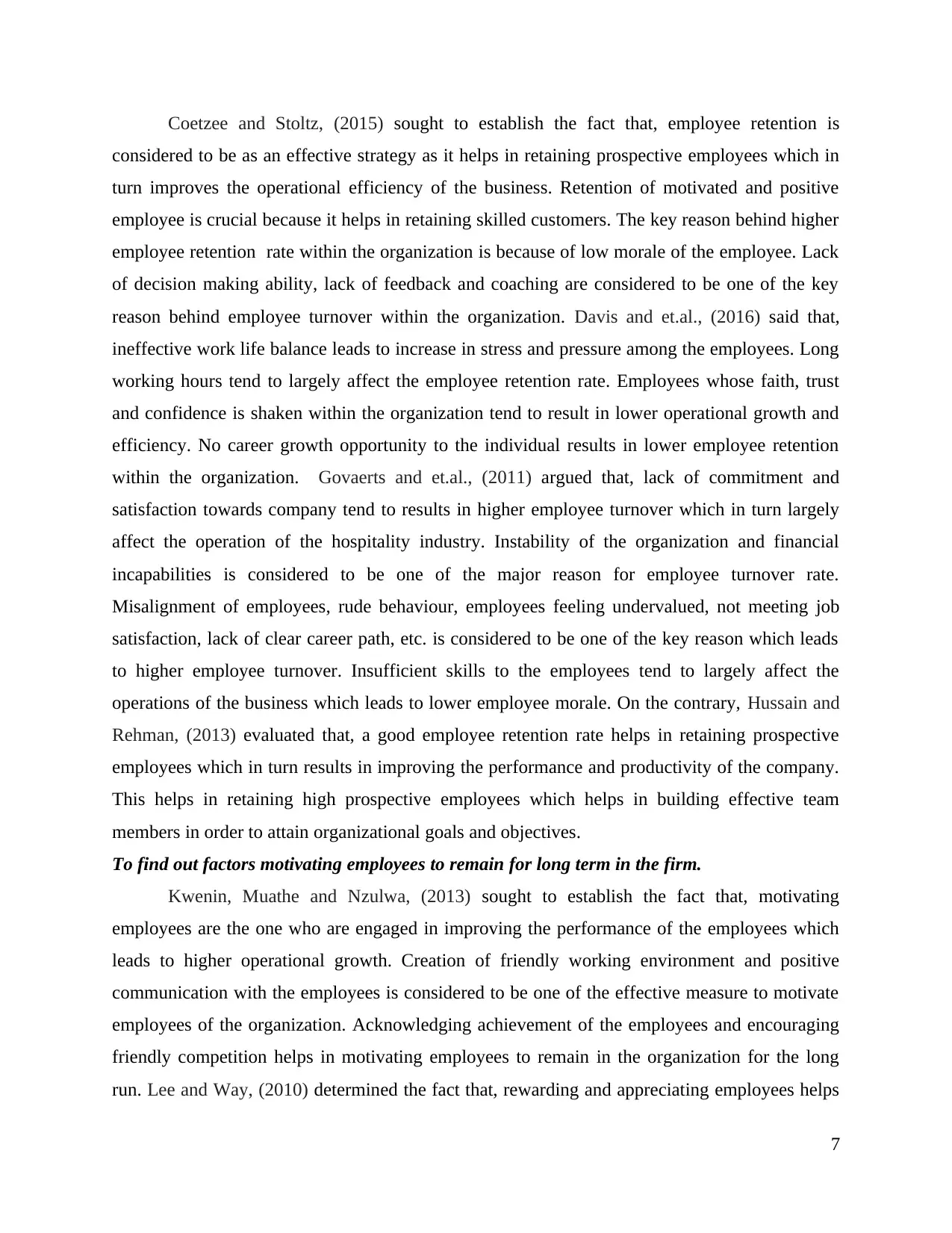
Coetzee and Stoltz, (2015) sought to establish the fact that, employee retention is
considered to be as an effective strategy as it helps in retaining prospective employees which in
turn improves the operational efficiency of the business. Retention of motivated and positive
employee is crucial because it helps in retaining skilled customers. The key reason behind higher
employee retention rate within the organization is because of low morale of the employee. Lack
of decision making ability, lack of feedback and coaching are considered to be one of the key
reason behind employee turnover within the organization. Davis and et.al., (2016) said that,
ineffective work life balance leads to increase in stress and pressure among the employees. Long
working hours tend to largely affect the employee retention rate. Employees whose faith, trust
and confidence is shaken within the organization tend to result in lower operational growth and
efficiency. No career growth opportunity to the individual results in lower employee retention
within the organization. Govaerts and et.al., (2011) argued that, lack of commitment and
satisfaction towards company tend to results in higher employee turnover which in turn largely
affect the operation of the hospitality industry. Instability of the organization and financial
incapabilities is considered to be one of the major reason for employee turnover rate.
Misalignment of employees, rude behaviour, employees feeling undervalued, not meeting job
satisfaction, lack of clear career path, etc. is considered to be one of the key reason which leads
to higher employee turnover. Insufficient skills to the employees tend to largely affect the
operations of the business which leads to lower employee morale. On the contrary, Hussain and
Rehman, (2013) evaluated that, a good employee retention rate helps in retaining prospective
employees which in turn results in improving the performance and productivity of the company.
This helps in retaining high prospective employees which helps in building effective team
members in order to attain organizational goals and objectives.
To find out factors motivating employees to remain for long term in the firm.
Kwenin, Muathe and Nzulwa, (2013) sought to establish the fact that, motivating
employees are the one who are engaged in improving the performance of the employees which
leads to higher operational growth. Creation of friendly working environment and positive
communication with the employees is considered to be one of the effective measure to motivate
employees of the organization. Acknowledging achievement of the employees and encouraging
friendly competition helps in motivating employees to remain in the organization for the long
run. Lee and Way, (2010) determined the fact that, rewarding and appreciating employees helps
7
considered to be as an effective strategy as it helps in retaining prospective employees which in
turn improves the operational efficiency of the business. Retention of motivated and positive
employee is crucial because it helps in retaining skilled customers. The key reason behind higher
employee retention rate within the organization is because of low morale of the employee. Lack
of decision making ability, lack of feedback and coaching are considered to be one of the key
reason behind employee turnover within the organization. Davis and et.al., (2016) said that,
ineffective work life balance leads to increase in stress and pressure among the employees. Long
working hours tend to largely affect the employee retention rate. Employees whose faith, trust
and confidence is shaken within the organization tend to result in lower operational growth and
efficiency. No career growth opportunity to the individual results in lower employee retention
within the organization. Govaerts and et.al., (2011) argued that, lack of commitment and
satisfaction towards company tend to results in higher employee turnover which in turn largely
affect the operation of the hospitality industry. Instability of the organization and financial
incapabilities is considered to be one of the major reason for employee turnover rate.
Misalignment of employees, rude behaviour, employees feeling undervalued, not meeting job
satisfaction, lack of clear career path, etc. is considered to be one of the key reason which leads
to higher employee turnover. Insufficient skills to the employees tend to largely affect the
operations of the business which leads to lower employee morale. On the contrary, Hussain and
Rehman, (2013) evaluated that, a good employee retention rate helps in retaining prospective
employees which in turn results in improving the performance and productivity of the company.
This helps in retaining high prospective employees which helps in building effective team
members in order to attain organizational goals and objectives.
To find out factors motivating employees to remain for long term in the firm.
Kwenin, Muathe and Nzulwa, (2013) sought to establish the fact that, motivating
employees are the one who are engaged in improving the performance of the employees which
leads to higher operational growth. Creation of friendly working environment and positive
communication with the employees is considered to be one of the effective measure to motivate
employees of the organization. Acknowledging achievement of the employees and encouraging
friendly competition helps in motivating employees to remain in the organization for the long
run. Lee and Way, (2010) determined the fact that, rewarding and appreciating employees helps
7
⊘ This is a preview!⊘
Do you want full access?
Subscribe today to unlock all pages.

Trusted by 1+ million students worldwide
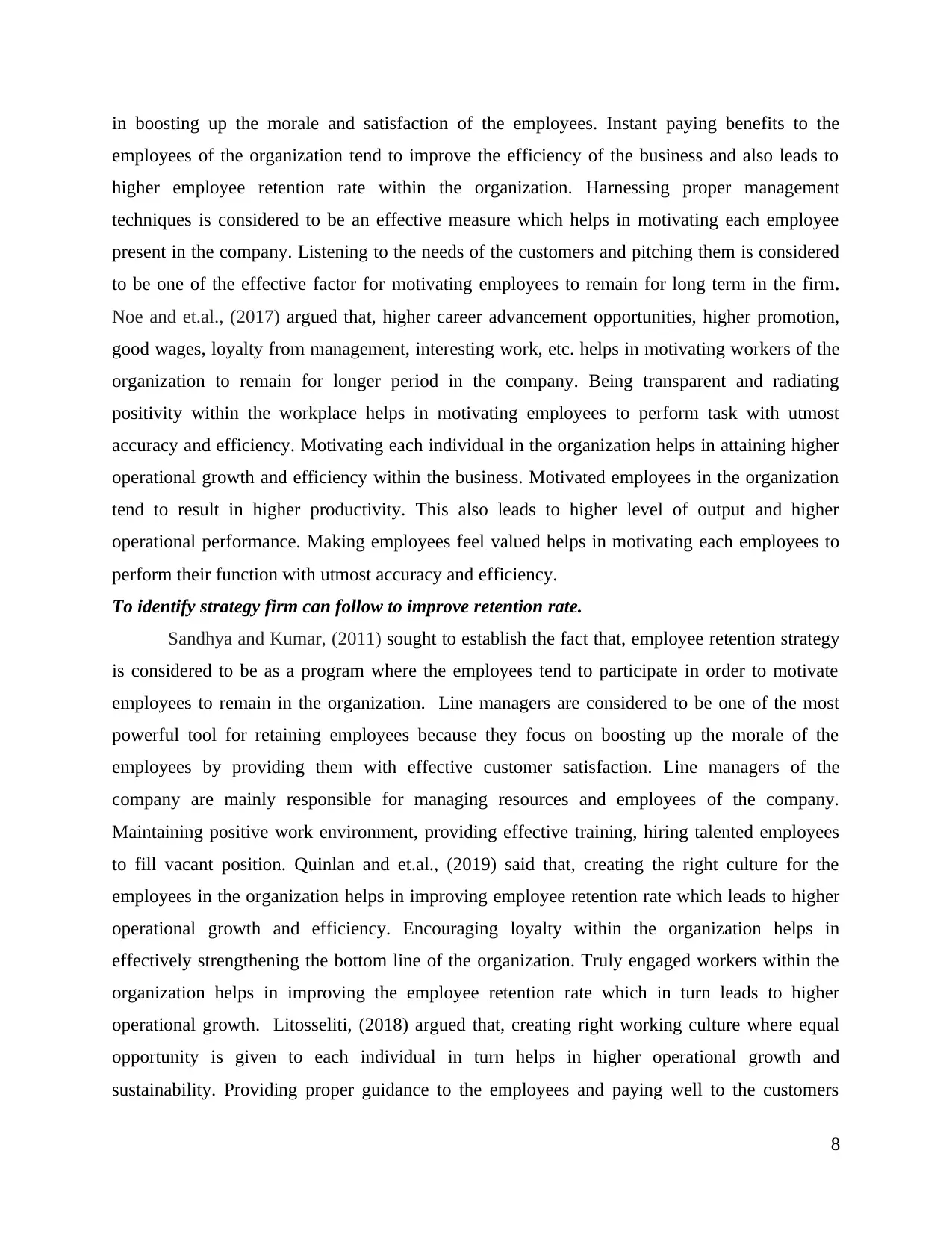
in boosting up the morale and satisfaction of the employees. Instant paying benefits to the
employees of the organization tend to improve the efficiency of the business and also leads to
higher employee retention rate within the organization. Harnessing proper management
techniques is considered to be an effective measure which helps in motivating each employee
present in the company. Listening to the needs of the customers and pitching them is considered
to be one of the effective factor for motivating employees to remain for long term in the firm.
Noe and et.al., (2017) argued that, higher career advancement opportunities, higher promotion,
good wages, loyalty from management, interesting work, etc. helps in motivating workers of the
organization to remain for longer period in the company. Being transparent and radiating
positivity within the workplace helps in motivating employees to perform task with utmost
accuracy and efficiency. Motivating each individual in the organization helps in attaining higher
operational growth and efficiency within the business. Motivated employees in the organization
tend to result in higher productivity. This also leads to higher level of output and higher
operational performance. Making employees feel valued helps in motivating each employees to
perform their function with utmost accuracy and efficiency.
To identify strategy firm can follow to improve retention rate.
Sandhya and Kumar, (2011) sought to establish the fact that, employee retention strategy
is considered to be as a program where the employees tend to participate in order to motivate
employees to remain in the organization. Line managers are considered to be one of the most
powerful tool for retaining employees because they focus on boosting up the morale of the
employees by providing them with effective customer satisfaction. Line managers of the
company are mainly responsible for managing resources and employees of the company.
Maintaining positive work environment, providing effective training, hiring talented employees
to fill vacant position. Quinlan and et.al., (2019) said that, creating the right culture for the
employees in the organization helps in improving employee retention rate which leads to higher
operational growth and efficiency. Encouraging loyalty within the organization helps in
effectively strengthening the bottom line of the organization. Truly engaged workers within the
organization helps in improving the employee retention rate which in turn leads to higher
operational growth. Litosseliti, (2018) argued that, creating right working culture where equal
opportunity is given to each individual in turn helps in higher operational growth and
sustainability. Providing proper guidance to the employees and paying well to the customers
8
employees of the organization tend to improve the efficiency of the business and also leads to
higher employee retention rate within the organization. Harnessing proper management
techniques is considered to be an effective measure which helps in motivating each employee
present in the company. Listening to the needs of the customers and pitching them is considered
to be one of the effective factor for motivating employees to remain for long term in the firm.
Noe and et.al., (2017) argued that, higher career advancement opportunities, higher promotion,
good wages, loyalty from management, interesting work, etc. helps in motivating workers of the
organization to remain for longer period in the company. Being transparent and radiating
positivity within the workplace helps in motivating employees to perform task with utmost
accuracy and efficiency. Motivating each individual in the organization helps in attaining higher
operational growth and efficiency within the business. Motivated employees in the organization
tend to result in higher productivity. This also leads to higher level of output and higher
operational performance. Making employees feel valued helps in motivating each employees to
perform their function with utmost accuracy and efficiency.
To identify strategy firm can follow to improve retention rate.
Sandhya and Kumar, (2011) sought to establish the fact that, employee retention strategy
is considered to be as a program where the employees tend to participate in order to motivate
employees to remain in the organization. Line managers are considered to be one of the most
powerful tool for retaining employees because they focus on boosting up the morale of the
employees by providing them with effective customer satisfaction. Line managers of the
company are mainly responsible for managing resources and employees of the company.
Maintaining positive work environment, providing effective training, hiring talented employees
to fill vacant position. Quinlan and et.al., (2019) said that, creating the right culture for the
employees in the organization helps in improving employee retention rate which leads to higher
operational growth and efficiency. Encouraging loyalty within the organization helps in
effectively strengthening the bottom line of the organization. Truly engaged workers within the
organization helps in improving the employee retention rate which in turn leads to higher
operational growth. Litosseliti, (2018) argued that, creating right working culture where equal
opportunity is given to each individual in turn helps in higher operational growth and
sustainability. Providing proper guidance to the employees and paying well to the customers
8
Paraphrase This Document
Need a fresh take? Get an instant paraphrase of this document with our AI Paraphraser
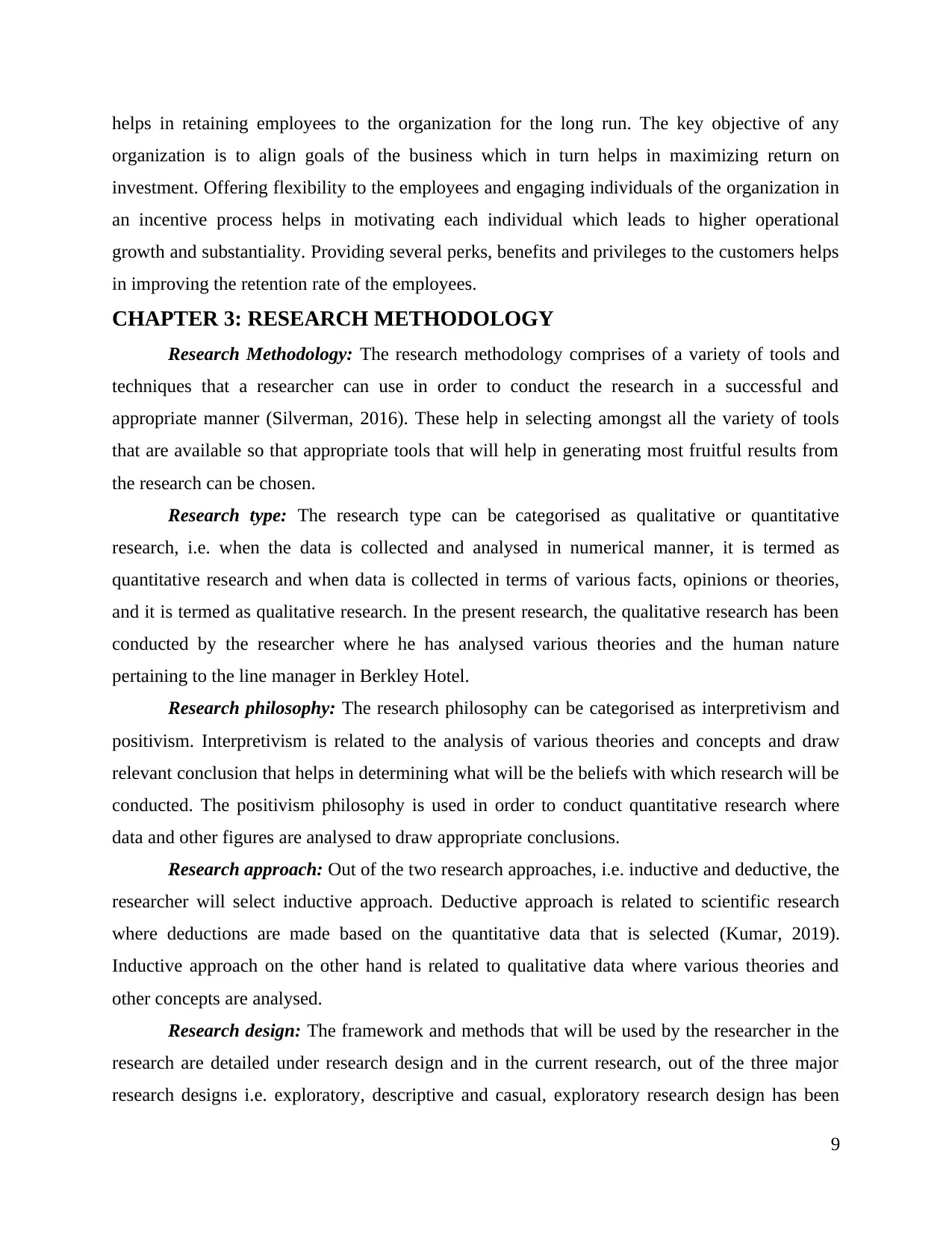
helps in retaining employees to the organization for the long run. The key objective of any
organization is to align goals of the business which in turn helps in maximizing return on
investment. Offering flexibility to the employees and engaging individuals of the organization in
an incentive process helps in motivating each individual which leads to higher operational
growth and substantiality. Providing several perks, benefits and privileges to the customers helps
in improving the retention rate of the employees.
CHAPTER 3: RESEARCH METHODOLOGY
Research Methodology: The research methodology comprises of a variety of tools and
techniques that a researcher can use in order to conduct the research in a successful and
appropriate manner (Silverman, 2016). These help in selecting amongst all the variety of tools
that are available so that appropriate tools that will help in generating most fruitful results from
the research can be chosen.
Research type: The research type can be categorised as qualitative or quantitative
research, i.e. when the data is collected and analysed in numerical manner, it is termed as
quantitative research and when data is collected in terms of various facts, opinions or theories,
and it is termed as qualitative research. In the present research, the qualitative research has been
conducted by the researcher where he has analysed various theories and the human nature
pertaining to the line manager in Berkley Hotel.
Research philosophy: The research philosophy can be categorised as interpretivism and
positivism. Interpretivism is related to the analysis of various theories and concepts and draw
relevant conclusion that helps in determining what will be the beliefs with which research will be
conducted. The positivism philosophy is used in order to conduct quantitative research where
data and other figures are analysed to draw appropriate conclusions.
Research approach: Out of the two research approaches, i.e. inductive and deductive, the
researcher will select inductive approach. Deductive approach is related to scientific research
where deductions are made based on the quantitative data that is selected (Kumar, 2019).
Inductive approach on the other hand is related to qualitative data where various theories and
other concepts are analysed.
Research design: The framework and methods that will be used by the researcher in the
research are detailed under research design and in the current research, out of the three major
research designs i.e. exploratory, descriptive and casual, exploratory research design has been
9
organization is to align goals of the business which in turn helps in maximizing return on
investment. Offering flexibility to the employees and engaging individuals of the organization in
an incentive process helps in motivating each individual which leads to higher operational
growth and substantiality. Providing several perks, benefits and privileges to the customers helps
in improving the retention rate of the employees.
CHAPTER 3: RESEARCH METHODOLOGY
Research Methodology: The research methodology comprises of a variety of tools and
techniques that a researcher can use in order to conduct the research in a successful and
appropriate manner (Silverman, 2016). These help in selecting amongst all the variety of tools
that are available so that appropriate tools that will help in generating most fruitful results from
the research can be chosen.
Research type: The research type can be categorised as qualitative or quantitative
research, i.e. when the data is collected and analysed in numerical manner, it is termed as
quantitative research and when data is collected in terms of various facts, opinions or theories,
and it is termed as qualitative research. In the present research, the qualitative research has been
conducted by the researcher where he has analysed various theories and the human nature
pertaining to the line manager in Berkley Hotel.
Research philosophy: The research philosophy can be categorised as interpretivism and
positivism. Interpretivism is related to the analysis of various theories and concepts and draw
relevant conclusion that helps in determining what will be the beliefs with which research will be
conducted. The positivism philosophy is used in order to conduct quantitative research where
data and other figures are analysed to draw appropriate conclusions.
Research approach: Out of the two research approaches, i.e. inductive and deductive, the
researcher will select inductive approach. Deductive approach is related to scientific research
where deductions are made based on the quantitative data that is selected (Kumar, 2019).
Inductive approach on the other hand is related to qualitative data where various theories and
other concepts are analysed.
Research design: The framework and methods that will be used by the researcher in the
research are detailed under research design and in the current research, out of the three major
research designs i.e. exploratory, descriptive and casual, exploratory research design has been
9
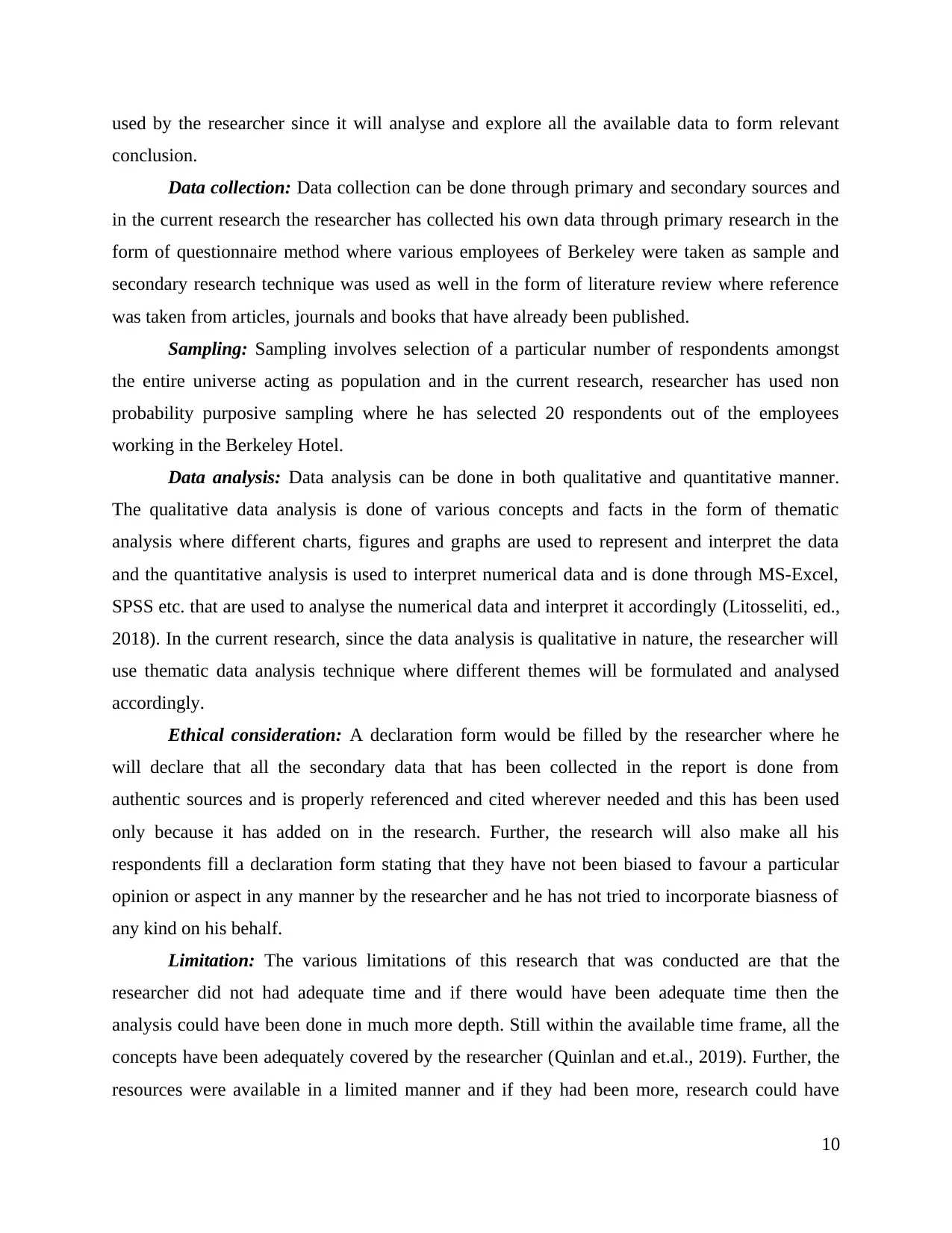
used by the researcher since it will analyse and explore all the available data to form relevant
conclusion.
Data collection: Data collection can be done through primary and secondary sources and
in the current research the researcher has collected his own data through primary research in the
form of questionnaire method where various employees of Berkeley were taken as sample and
secondary research technique was used as well in the form of literature review where reference
was taken from articles, journals and books that have already been published.
Sampling: Sampling involves selection of a particular number of respondents amongst
the entire universe acting as population and in the current research, researcher has used non
probability purposive sampling where he has selected 20 respondents out of the employees
working in the Berkeley Hotel.
Data analysis: Data analysis can be done in both qualitative and quantitative manner.
The qualitative data analysis is done of various concepts and facts in the form of thematic
analysis where different charts, figures and graphs are used to represent and interpret the data
and the quantitative analysis is used to interpret numerical data and is done through MS-Excel,
SPSS etc. that are used to analyse the numerical data and interpret it accordingly (Litosseliti, ed.,
2018). In the current research, since the data analysis is qualitative in nature, the researcher will
use thematic data analysis technique where different themes will be formulated and analysed
accordingly.
Ethical consideration: A declaration form would be filled by the researcher where he
will declare that all the secondary data that has been collected in the report is done from
authentic sources and is properly referenced and cited wherever needed and this has been used
only because it has added on in the research. Further, the research will also make all his
respondents fill a declaration form stating that they have not been biased to favour a particular
opinion or aspect in any manner by the researcher and he has not tried to incorporate biasness of
any kind on his behalf.
Limitation: The various limitations of this research that was conducted are that the
researcher did not had adequate time and if there would have been adequate time then the
analysis could have been done in much more depth. Still within the available time frame, all the
concepts have been adequately covered by the researcher (Quinlan and et.al., 2019). Further, the
resources were available in a limited manner and if they had been more, research could have
10
conclusion.
Data collection: Data collection can be done through primary and secondary sources and
in the current research the researcher has collected his own data through primary research in the
form of questionnaire method where various employees of Berkeley were taken as sample and
secondary research technique was used as well in the form of literature review where reference
was taken from articles, journals and books that have already been published.
Sampling: Sampling involves selection of a particular number of respondents amongst
the entire universe acting as population and in the current research, researcher has used non
probability purposive sampling where he has selected 20 respondents out of the employees
working in the Berkeley Hotel.
Data analysis: Data analysis can be done in both qualitative and quantitative manner.
The qualitative data analysis is done of various concepts and facts in the form of thematic
analysis where different charts, figures and graphs are used to represent and interpret the data
and the quantitative analysis is used to interpret numerical data and is done through MS-Excel,
SPSS etc. that are used to analyse the numerical data and interpret it accordingly (Litosseliti, ed.,
2018). In the current research, since the data analysis is qualitative in nature, the researcher will
use thematic data analysis technique where different themes will be formulated and analysed
accordingly.
Ethical consideration: A declaration form would be filled by the researcher where he
will declare that all the secondary data that has been collected in the report is done from
authentic sources and is properly referenced and cited wherever needed and this has been used
only because it has added on in the research. Further, the research will also make all his
respondents fill a declaration form stating that they have not been biased to favour a particular
opinion or aspect in any manner by the researcher and he has not tried to incorporate biasness of
any kind on his behalf.
Limitation: The various limitations of this research that was conducted are that the
researcher did not had adequate time and if there would have been adequate time then the
analysis could have been done in much more depth. Still within the available time frame, all the
concepts have been adequately covered by the researcher (Quinlan and et.al., 2019). Further, the
resources were available in a limited manner and if they had been more, research could have
10
⊘ This is a preview!⊘
Do you want full access?
Subscribe today to unlock all pages.

Trusted by 1+ million students worldwide
1 out of 27
Related Documents
Your All-in-One AI-Powered Toolkit for Academic Success.
+13062052269
info@desklib.com
Available 24*7 on WhatsApp / Email
![[object Object]](/_next/static/media/star-bottom.7253800d.svg)
Unlock your academic potential
Copyright © 2020–2025 A2Z Services. All Rights Reserved. Developed and managed by ZUCOL.




